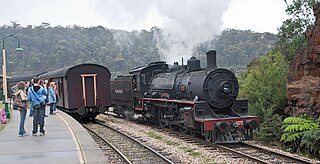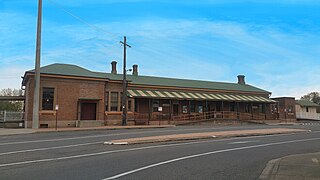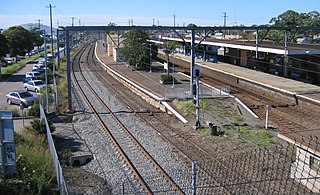
CityRail was a passenger railway brand operated by the State Rail Authority from 1989 to 2003 and by RailCorp from 2003 to 2013 with services in and around Sydney, Newcastle and Wollongong, the three largest cities in New South Wales, Australia. It was established in January 1989 and abolished in June 2013 when it was superseded by Sydney Trains and NSW TrainLink.

Waterfall railway station is located on the Illawarra line, serving the Sydney suburb of Waterfall. It is served by Sydney Trains T4 Illawarra line services and NSW TrainLink South Coast Line services.

The Zig Zag Railway is an Australian heritage railway, situated near Lithgow, New South Wales. It was opened by the not-for-profit Zig Zag Railway Co-op as an unpaid volunteer-staffed heritage railway in October 1975, using the alignment of the Lithgow Zig Zag line that formed part of the Main Western line between 1869 and 1910. The line climbs the western flank of the Blue Mountains, using railway zig zags to gain height.

The Main North Line is a major railway in New South Wales, Australia. It runs through Strathfield to Armidale. The line is the main line between Sydney and Armidale. As of 1988, the line closed progressively north of Armidale with services gradually withdrawn till 2004, with the main route between Sydney and Brisbane now the North Coast line.

Singleton railway station is a heritage-listed railway station located on the Main Northern line in New South Wales, Australia. It serves the town of Singleton. It was added to the New South Wales State Heritage Register on 2 April 1999.

The South Coast Line (SCO) is an intercity rail service operated by NSW TrainLink that services the Illawarra region of New South Wales, Australia. The service runs from Central, and runs the entire length of the eponymous South Coast railway line to Bomaderry. The service also runs along the Eastern Suburbs railway line at peak hours and the Port Kembla railway line to Port Kembla. It is operated with NSW TrainLink H sets and Sydney Trains T sets, with Endeavour railcars operating the service on the non-electrified line between Kiama and Bomaderry.

The Belmont railway line is an abandoned coal haulage and passenger rail line from Adamstown, New South Wales to Belmont, New South Wales. This was a private railway, being the property of the New Redhead Estate and Coal Company and was generally known as the Belmont Branch. The line closed in December 1991. It has since been converted into a cycleway or rail trail - The Fernleigh Track.

Lochinvar railway station is located on the Main Northern line in New South Wales, Australia. It serves the nearby town of Lochinvar opening on 2 July 1860.

Maitland railway station is located on the Main Northern line in New South Wales, Australia. It serves the city of Maitland opening on in 1880 as West Maitland being renamed on 1 April 1949. It is the junction station for the Main Northern and North Coast lines. It was added to the New South Wales State Heritage Register on 2 April 1999.

3801 is a 4-6-2 steam locomotive operated by the New South Wales Government Railways between 1943 and 1974. It is arguably Australia's most famous steam locomotive, being the only one to have visited all mainland states and territories.

Wickham railway station is a former railway station which was located in the Newcastle suburb of Wickham, New South Wales. Situated on the Newcastle railway line, it was serviced by Central Coast & Newcastle Line and Hunter Line services until its closure. Wickham, along with Civic station, succeeded Honeysuckle station, which was closed in 1872, following its own replacement by Newcastle station. Following urban growth in the Newcastle region, both Wickham and Civic were opened to meet the growing demand for public transport in the region. The station's signal box, located at the station's western end at Stewart Avenue, was replaced in the 1960s with a building recognised as Australia's first television-equipped level crossing.

Broadmeadow railway station is a major regional interchange located on the Main Northern Line. The station itself serves the Newcastle suburb of Broadmeadow. The station was first opened on 15 August 1887.

Cockle Creek railway station is located on the Main Northern line in New South Wales, Australia. It serves the City of Lake Macquarie suburb of Boolaroo. The station is on the eastern side of Cockle Creek and a balloon loop exists west of the creek for the Teralba Colliery.

Sandgate railway station is located on the Main Northern line in New South Wales, Australia. It serves the western Newcastle suburb of Sandgate, opening in 1881 as Grant's Creek.

Hexham railway station is located on the Main Northern line in New South Wales, Australia. It serves the western Newcastle suburb of Hexham, and was opened on 1 August 1871.

Muswellbrook railway station is a heritage-listed railway station located on the Main Northern line in Muswellbrook, in the Muswellbrook Shire local government area of New South Wales, Australia. The station serves the town of Muswellbrook and was designed by John Whitton, the Chief Engineer of NSW Railways. It is also known as Muswellbrook Railway Station and yard group and Musclebrook Railway Station. The property was added to the New South Wales State Heritage Register on 2 April 1999.
Beresfield is a north-western suburb of Newcastle, New South Wales, Australia 22 kilometres (14 mi) from Newcastle's central business district. It is part of the City of Newcastle local government area.
The railways of New South Wales, Australia have had many incidents and accidents since their formation in 1831. There are close to 1000 names associated with rail-related deaths in NSW on the walls of the Australian Railway Monument in Werris Creek. Those killed were all employees of various NSW railways. The details below include deaths of employees and the general public.
On 3 February 2003, a Comeng electric multiple unit train rolled away from Broadmeadows station in Melbourne, Australia, before it ran for nearly 17 kilometres (11 mi) out of control without a driver and eventually crashed into another train about to depart Spencer Street station. Train controllers attempted several times to stop or redirect the train, but were limited in their ability to intervene, instead being forced to alter the route of other trains to avert a more serious collision. Eleven people on board the stationary train were injured; authorities did not know until after the crash if any passengers were on board the runaway. An investigation identified driver error as the cause of the accident, but the runaway event prompted significant debate about the role of government authorities and private operators in ensuring safety and reliability on the Melbourne rail network.

















